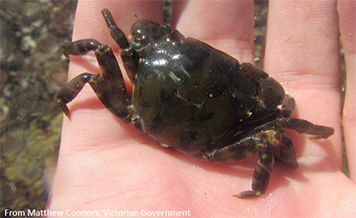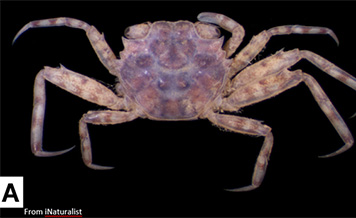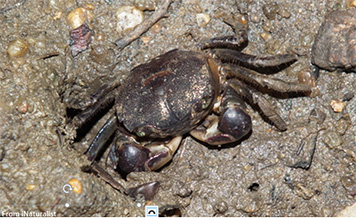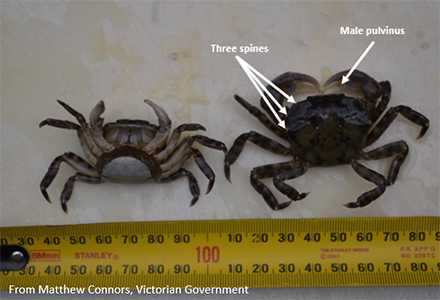Asian shore crab (Hemigrapsus sanguineus) competes with and preys on crabs, and shellfish, particularly juvenile mussels or oysters.
What to look for
Features:
- squarish shell, green–purple to orange–brown to red
- three spines along the outside of the shell behind each eye
- banding pattern on walking legs – distinguishing feature in juveniles
- red spots on claws
- males have a bulbous projection (pulvinus) on the bottom finger of each claw
- shell up to 5cm wide
- no hairs on the legs
- ridge below the eye is finely striated
- Shell is a smooth undeviating line between the eyes.
Where to look
Look in or around:
- artificial structures
- under debris, rocks and shells
- mud.
Likely habitats include:
- intertidal rocky coasts
- shallow water; if population is high and competition for space exists.
Established in Victoria . Asian shore crabs were detected in Port Phillip Bay in 2020.
Similar native species
These native species look similar to Asian shore crab. They do not need to be reported.
Ilyograpsus paludicola
Features:
- yellow shell with mottled red, brown and purple markings
- no spines to sides of eyes
- smooth rounded shell up to 4cm wide.
Habitat:
- sheltered or moderately exposed rocky and boulder-covered shores.
Pseudohelice subquadrata
Features:
- has fewer spines along its shell
- hair on legs
Habitat:
- intertidal zones, estuaries, salt marshes and within mangroves
Known habitat:
- Is widely distributed in tropical zones throughout the Indian Ocean and South Pacific Ocean
Report it
See something unusual? Report it. Even if you’re not sure.
If you see something you think is a pest:
- note the exact location (screenshot your map app or enable photo geotagging on your phone)
- take a photo (use something for size reference, for example a coin)
- contact your state or territory authority.
Stop the spread of marine pests
Start with these simple steps:
- Inspect and clean your boat or yacht. Make sure you check hard to reach areas.
- Treat the hull of your boat or yacht regularly.
- Clean and dry your fishing and diving gear after every use.
How you can stop the spread of marine pests.
Your location
The map shows known pests and pests to look for around Australia.





